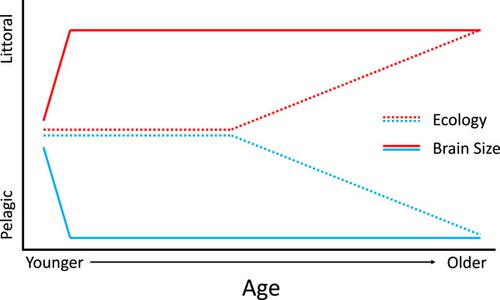当前位置:
X-MOL 学术
›
Evol. Dev.
›
论文详情
Our official English website, www.x-mol.net, welcomes your
feedback! (Note: you will need to create a separate account there.)
Isolating the effects of ontogenetic niche shift on brain size development using pumpkinseed sunfish ecotypes.
Evolution and Development ( IF 2.6 ) Pub Date : 2020-03-11 , DOI: 10.1111/ede.12333 Caleb J Axelrod 1 , Frédéric Laberge 1 , Beren W Robinson 1
Evolution and Development ( IF 2.6 ) Pub Date : 2020-03-11 , DOI: 10.1111/ede.12333 Caleb J Axelrod 1 , Frédéric Laberge 1 , Beren W Robinson 1
Affiliation

|
A functional relationship between relative brain size and cognitive performance has been hypothesized. However, the influence of ontogenetic niche shifts on cognitive performance is not well understood. Increases in body size can affect niche use but distinguishing nonecologically relevant brain development from effects associated with ecology is difficult. If survival is enhanced by functional changes in ecocognitive performance over ontogeny, then brain size development should track ontogenetic shifts in ecology. We control for nonecologically relevant brain size development by comparing brain growth between two ecotypes of Pumpkinseed sunfish whose ecologies diverge over ontogeny from a shared juvenile niche. Brain size differs between ecotypes from their birth year onwards even though their foraging ecology appears to diverge at age 3. This finding suggests that the eco‐cognitive requirements of adult niches shape early life brain growth more than the requirements of juvenile ecology.
中文翻译:

使用南瓜籽翻车鱼生态型隔离个体发育的生态位转移对大脑大小发育的影响。
已经假设相对大脑大小和认知能力之间存在功能关系。但是,尚无关于个体发育的生态位转移对认知能力的影响的信息。体型的增加会影响利基的使用,但是很难将非生态相关的大脑发育与生态相关的效应区分开。如果通过个体发育过程中生态认知功能的功能性改变来提高生存率,那么大脑大小的发展应该跟踪个体发育过程中生态学的变化。我们通过比较两种生态型南瓜籽翻车鱼的大脑生长来控制非生态学上相关的大脑大小发育,南瓜翻车鱼的生态学会从一个共同的生境中分化为个体发育。尽管他们的觅食生态在3岁时就出现了分歧,但从出生年份开始,不同生态类型的大脑大小有所不同。
更新日期:2020-03-11
中文翻译:

使用南瓜籽翻车鱼生态型隔离个体发育的生态位转移对大脑大小发育的影响。
已经假设相对大脑大小和认知能力之间存在功能关系。但是,尚无关于个体发育的生态位转移对认知能力的影响的信息。体型的增加会影响利基的使用,但是很难将非生态相关的大脑发育与生态相关的效应区分开。如果通过个体发育过程中生态认知功能的功能性改变来提高生存率,那么大脑大小的发展应该跟踪个体发育过程中生态学的变化。我们通过比较两种生态型南瓜籽翻车鱼的大脑生长来控制非生态学上相关的大脑大小发育,南瓜翻车鱼的生态学会从一个共同的生境中分化为个体发育。尽管他们的觅食生态在3岁时就出现了分歧,但从出生年份开始,不同生态类型的大脑大小有所不同。











































 京公网安备 11010802027423号
京公网安备 11010802027423号